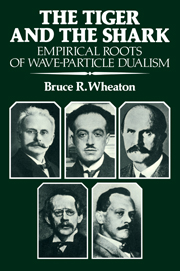Book contents
- Frontmatter
- Contents
- Foreword by Thomas S. Kuhn
- Preface
- Notes on sources
- 1 Introduction
- Part I The introduction of temporal discontinuity, 1896–1905
- 2 The electromagnetic impulse hypothesis of x-rays
- 3 The analogy between γ-rays and x-rays
- Part II Ionization and the recognition of paradox, 1906–1910
- Part III Seeking an electrodynamic solution, 1907–1912
- Part IV Interference of x-rays and the corroboration of paradox, 1912–1922
- Part V The conceptual origins of wave–particle dualism, 1921–1925
- Epilogue: The tiger and the shark
- Bibliography
- Index
2 - The electromagnetic impulse hypothesis of x-rays
Published online by Cambridge University Press: 04 August 2010
- Frontmatter
- Contents
- Foreword by Thomas S. Kuhn
- Preface
- Notes on sources
- 1 Introduction
- Part I The introduction of temporal discontinuity, 1896–1905
- 2 The electromagnetic impulse hypothesis of x-rays
- 3 The analogy between γ-rays and x-rays
- Part II Ionization and the recognition of paradox, 1906–1910
- Part III Seeking an electrodynamic solution, 1907–1912
- Part IV Interference of x-rays and the corroboration of paradox, 1912–1922
- Part V The conceptual origins of wave–particle dualism, 1921–1925
- Epilogue: The tiger and the shark
- Bibliography
- Index
Summary
The Röntgen emanation consists of a vast succession of independent pulses …
Between 1898 and 1912, a majority of physicists thought that x-rays were impulses propagating through the electromagnetic field. Only the extremely large number of pulses gave the x-ray beam its seeming continuity. Although this hypothesis was compatible with the wave theory of light, it was a special case of that theory. Impulses are not ordinary waves. Although they propagate spherically outward from their source, pulses are not periodic oscillations. The energy in an impulse is temporally but not spatially localized. It is contained within an ever-expanding shell, but the shell's radial thickness remains constant and small. Along the circumference, energy is distributed uniformly. But radially, from front to back so to speak, electromagnetic energy rises quickly from zero and drops back just as rapidly. When it passes a point in space, an impulse exerts only a single push or a single push – pull. A pulse collides, rather than resonates, with an atom.
In their temporal discontinuity, impulses differ decisively from their periodic-wave cousins. Light has an intrinsic oscillatory character that allows it to interfere; the superposition of two beams of coherent monochromatic light produces alternate regions of constructive and destructive interaction, the well-known interference fringes. A pulse has no oscillatory structure. Its interference properties are qualitatively different from those of light. A truly monochromatic light wave must extend infinitely in time; if it does not, an intrinsic ambiguity arises in the definition of its frequency. A pulse is restricted in temporal extent, and the very concept of frequency cannot readily be applied.
Information
- Type
- Chapter
- Information
- The Tiger and the SharkEmpirical Roots of Wave-Particle Dualism, pp. 15 - 48Publisher: Cambridge University PressPrint publication year: 1983
Accessibility standard: Unknown
Why this information is here
This section outlines the accessibility features of this content - including support for screen readers, full keyboard navigation and high-contrast display options. This may not be relevant for you.Accessibility Information
- 1
- Cited by
